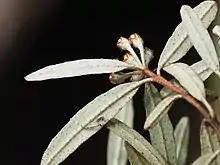Phebalium woombye
Phebalium woombye, commonly known as wallum phebalium,[2] is a species of shrub that is endemic to eastern Australia. It has branchlets covered with scales and star-shaped hairs, elliptical leaves, and white to pink flowers arranged in umbels of four to ten flowers.
| Wallum phebalium | |
|---|---|
.jpg.webp) | |
| In Sherwood Nature Reserve, near Glenreagh | |
| Scientific classification | |
| Kingdom: | Plantae |
| Clade: | Tracheophytes |
| Clade: | Angiosperms |
| Clade: | Eudicots |
| Clade: | Rosids |
| Order: | Sapindales |
| Family: | Rutaceae |
| Genus: | Phebalium |
| Species: | P. woombye |
| Binomial name | |
| Phebalium woombye | |
| Synonyms[1] | |
| |

Description
Phebalium woombye is a shrub that typically grows to a height of 2 m (6 ft 7 in) and has branchlets covered with scales and star-shaped hairs. The leaves are oblong to elliptical, 15–60 mm (0.59–2.36 in) long and 2–11 mm (0.079–0.433 in) wide on a short petiole. The upper surface of the leaves is flat and glabrous, the lower surface with a prominent mid-vein and covered with silvery scales. The flowers are arranged on the ends of branchlets in umbels of four to ten, each flower on a pedicel 4–15 mm (0.16–0.59 in) long. The calyx is top-shaped, about 3 mm (0.12 in) long with teeth about half that length, covered with silvery to rust-coloured scales inside and out. The petals are white to pink, egg-shaped with the narrower end towards the base, about 6 mm (0.24 in) long, 2.5 mm (0.098 in) wide and covered with rust-coloured scales on the back. Flowering occurs from July to August.[2][3][4][5]
Taxonomy and naming
This species was first formally described in 1898 by Frederick Manson Bailey who gave it the name Asterolasia woombye and published the description in the Queensland Agricultural Journal from specimens collected near Woombye.[6] In 1913 Karel Domin changed the name to Phebalium woombye, publishing the change in the journal Repertorium Specierum Novarum Regni Vegetabilis.[7][8]
Distribution and habitat
Phebalium woombye mainly grows in coastal sand dunes, sometimes further inland and is found from south-east Queensland to as far south as Glenreagh in New South Wales.[2][3]
References
- "Phebalium woombye". Australian Plant Census. Retrieved 23 June 2020.
- Weston, Paul H.; Harden, Gwen J. "Phebalium woombye". Royal Botanic Gardens Sydney. Retrieved 23 June 2020.
- Wilson, Paul G. "Phebalium woombye". Australian Biological Resources Study, Department of Agriculture, Water and the Environment, Canberra. Retrieved 22 June 2020.
- Wilson, Paul G. (1970). "A Taxonomic Revision of the Genera Crowea, Eriostemon and Phebalium (Rutaceae). Nuytsia 1(1):". Nuytsia. 1 (1): 88. Retrieved 22 June 2020.
- "Phebalium woombye". Australian Native Plants Society (Australia). Retrieved 23 June 2020.
- "Asterolasia woombye". APNI. Retrieved 22 June 2020.
- "Phebalium woombye". APNI. Retrieved 22 June 2020.
- Domin, Karel (1913). "Seventh contribution to the flora of Australia". Repertorium Specierum Novarum Regni Vegetabilis. 12: 133. Retrieved 23 June 2020.